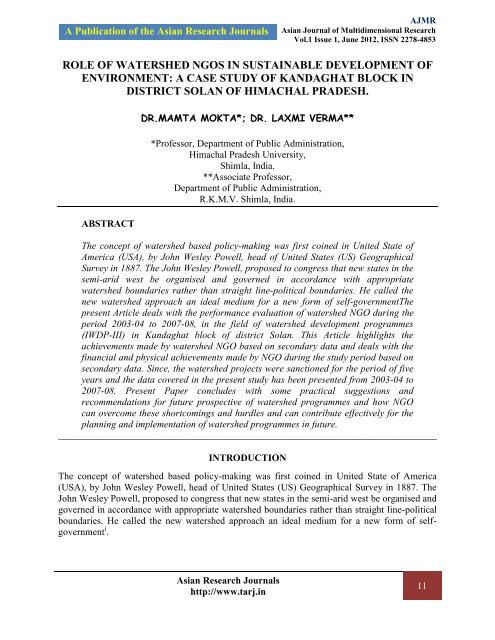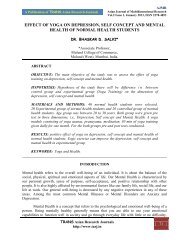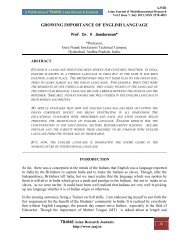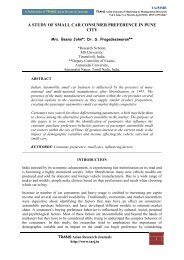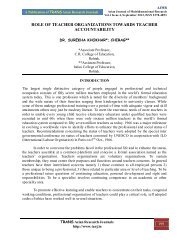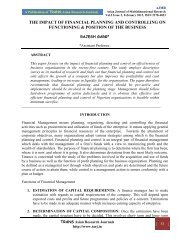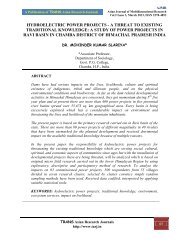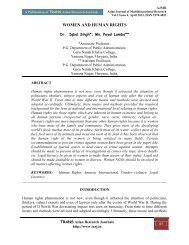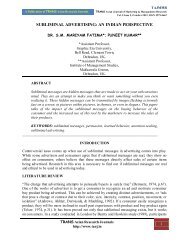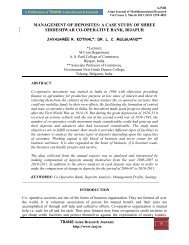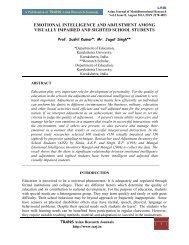5.2, DR. MAMTA MOKTA.pdf - tarj.in
5.2, DR. MAMTA MOKTA.pdf - tarj.in
5.2, DR. MAMTA MOKTA.pdf - tarj.in
- No tags were found...
Create successful ePaper yourself
Turn your PDF publications into a flip-book with our unique Google optimized e-Paper software.
A Publication of the Asian Research JournalsAJMRAsian Journal of Multidimensional ResearchVol.1 Issue 1, June 2012, ISSN 2278-4853Total 35,67,000 34,39,797 (96.29) 1,27,203Jalagam Vikas Sangh Giri River North 3-4 (Nagali), IWDP-III, Kandaghat Block, DistrictSolan2003-04 8,41,700 8,31,200 (98.76) 10,500 <strong>DR</strong>DA Solan2004-05 7,95,000 7,92,524 (99.69) 2,476 <strong>DR</strong>DA Solan2005-06 4,55,000 3,81,931 (83.95) 73,069 <strong>DR</strong>DA Solan2006-07 3,52,000 2,66,800 (75.79) 85,200 <strong>DR</strong>DA Solan2007-08 4,46,200 4,31,000 (96.59) 15,200 <strong>DR</strong>DA SolanTotal 28,89,900 27,03,455 (93.55) 1,86,445Jalagam Vikas Sangh Giri River North-2 (Kanauri-Nagali), IWDP-III, Kandaghat Block,District Solan2003-04 5,55,300 5,55,300 (100) - <strong>DR</strong>DA Solan2004-05 2,63,000 2,63,000 (100) - <strong>DR</strong>DA Solan2005-06 3,32,600 3,18,600 (95.79) 14,000 <strong>DR</strong>DA Solan2006-07 2,28,600 2,10,600 (92.13) 18,000 <strong>DR</strong>DA Solan2007-08 2,70,200 2,52,200 (93.34) 18,000 <strong>DR</strong>DA SolanTotal 16,49,700 15,99,700 (96.97) 50,000Source: 1. Block Development Office, Kandaghat2. The figures <strong>in</strong> the parenthesis <strong>in</strong>dicate percentage (%)Table I reveals that all the selected watershed NGO have utilized their maximum fundsreleased by <strong>DR</strong>DA <strong>in</strong> every year. The table <strong>in</strong>dicates that Jalagam Vikas Sangh Ashwani RiverNorth-3 has exceptionally utilized (100.00 per cent) of released funds every year, which is highlysatisfactory. The table further shows that the rest of the watershed NGO viz. Ashwani RiverNorth-4, Giri River North 3-4 and Giri River North-2 have achieved (93.55 per cent), (96.29 percent) and (96.97 per cent) f<strong>in</strong>ancial achievement, which is aga<strong>in</strong> significant. It can be concludedthat all NGOs have utilized the sanction funds <strong>in</strong> the given time and period.Asian Research Journalshttp://www.<strong>tarj</strong>.<strong>in</strong>15
A Publication of the Asian Research JournalsAJMRAsian Journal of Multidimensional ResearchVol.1 Issue 1, June 2012, ISSN 2278-4853Table II presented the year-wise consolidated detail of funds released and expenditure<strong>in</strong>curred by selected watershed NGO <strong>in</strong> the study area.TABLE IIYEAR-WISE DETAIL OF FUNDS RELEASED AND EXPENDITURE INCURREDDURING THE STUDY PERIOD I.E. 2003-04 TO 2007-08 IN SELECTED WATERSHEDNGO UNDER IWDP-III, KANDAGHAT BLOCK (CONSOLIDATED DETAIL)Year Total release Total expenditure Percentage2003-04 27,37,000 26,74,637 (97.73)2004-05 27,53,000 27,50,524 (99.92)2005-06 15,80,400 14,88,331 (94.18)2006-07 21,70,600 20,52,596 (94.57)2007-08 1,70,600 16,12,864 (94.79)Total 1,09,42,600 1,05,78,952 (96.68)Source: 1. Block Development Office, Kandaghat2. The figures <strong>in</strong> the parenthesis <strong>in</strong>dicate percentage (%)Table II depicts that although there has been maximum utilization of funds released by<strong>DR</strong>DA to the selected watershed NGO every year. But, the significant hike <strong>in</strong> the utilization offunds has been found <strong>in</strong> the year 2004-05 with (99.92 per cent) achievements followed by (97.73per cent) f<strong>in</strong>ancial achievement <strong>in</strong> the year 2003-04. Further, the achievement dur<strong>in</strong>g the year2007-08 has been found (94.79 per cent) and followed by (94.57 per cent) achievement <strong>in</strong> theyear 2006-07 respectively. Further, the table shows that the f<strong>in</strong>ancial achievement dur<strong>in</strong>g themiddle year 2005-06 was (94.18 per cent). The hike <strong>in</strong> the utilization of funds <strong>in</strong> the second yearmay be due to the proper settlement and understand<strong>in</strong>g about watershed programmes. It can beanalysed from the table that overall utilization of funds <strong>in</strong> all the watershed NGO has been found(96.68 per cent), which is highly satisfactory and <strong>in</strong>dicates that all NGOs have utilized the fundssanctioned by <strong>DR</strong>DA <strong>in</strong> a efficient manner to complete the work component.The detail of physical achievement and funds released and expenditure <strong>in</strong>curred <strong>in</strong>selected watershed NGO is presented <strong>in</strong> the table IIIAsian Research Journalshttp://www.<strong>tarj</strong>.<strong>in</strong>16
A Publication of the Asian Research JournalsAJMRAsian Journal of Multidimensional ResearchVol.1 Issue 1, June 2012, ISSN 2278-4853TABLE IIIYEAR-WISE ACTIVITY-WISE DETAIL OF FUNDS RELEASED AND EXPENDITURE INCURRED IN SELECTEDWATERSHED NGO IN STUDY AREA UNDER IWDP-III, KANDAGHAT BLOCKYear Activity TotalSumEntry Po<strong>in</strong>t Activity Soil Conservation S/C Water Harvest<strong>in</strong>g W/HEPATotalExpenditureTotalExpenditure<strong>in</strong> %SanctionExpenditureSanctionExpenditureSanctionExpenditure(S)(E)(S)(E)(S)(E)Jalagam Vikas Sangh Ashwani River North-3 (Chail - Jhajja) IWDP-III2003-04 30,000 30,000 4,20,000 4,20,000 1,90,000 1,90,000 6,40,000 6,40,000 (100.00)2004-05 70,000 70,000 2,40,000 2,40,000 4,30,000 4,30,000 7,40,000 7,40,000 (100.00)2005-06 84,500 84,500 80,000 80,000 96,300 96,300 2,60,800 2,60,800 (100.00)2006-07 - - 4,50,000 4,50,000 4,00,000 4,00,000 8,50,000 8,50,000 (100.00)2007-08 - - 1,10,000 1,10,000 2,35,200 2,35,200 3,45,200 3,45,200 (100.00)Total 1,84,500 1,84,500 13,00,000 13,00,000 13,51,500 13,51,500 28,36,000 28,36,000 (100.00)% - (100.00) - (100.00) - (100.00) - (100.00)Jalagam Vikas Sangh Ashwani River North-4 (Danghil - Jhajja) IWDP-III2003-04 1,20,000 1,20,000 50,000 45,407 5,30,000 4,82,730 7,00,000 6,48,137 (92.59)Asian Research Journalshttp://www.<strong>tarj</strong>.<strong>in</strong>17
A Publication of the Asian Research JournalsAJMRAsian Journal of Multidimensional ResearchVol.1 Issue 1, June 2012, ISSN 2278-48532004-05 61,000 61,000 1,00,000 1,00,000 1,02,000 1,02,000 2,63,000 2,63,000 (100.00)2005-06 - - 2,22,600 2,08,600 1,10,000 1,10,000 3,32,600 3,18,600 (95.79)2006-07 - - 58,600 58,600 1,70,000 1,52,000 2,28,600 2,10,600 (92.13)2007-08 - - 80,200 80,200 1,90,000 1,72,000 2,70,200 2,52,200 (93.34)Total 1,11,000 1,11,000 6,51,400 6,37,400 8,87,300 8,51,300 16,49,700 15,99,700 (97.97)% - (100.00) - (97.85) - (95.95) - (96.97)Source: 1. Block Development Office, Kandaghat2. The figures <strong>in</strong> the parenthesis <strong>in</strong>dicate percentage (%)Table III reveals that although all selected watershed NGOs have achieved their maximum targets and had utilized theirmaximum funds <strong>in</strong> every activity undertaken <strong>in</strong> the study area. But Jalagam Vikas Sangh Ashwani River North-3 has exceptionallyachieved (100.00 per cent) f<strong>in</strong>ancial targets <strong>in</strong> every year on each activity i.e. Entry Po<strong>in</strong>t Activity (EPA) (100 per cent), soilconservation with (100.00 per cent) and water harvest<strong>in</strong>g with (100.00 per cent) which is highly significant. The data further showsthat the other watershed NGO <strong>in</strong>clud<strong>in</strong>g Ashwani River North-3, Giri River North-2 and Giri River North 3-4 have utilized more than(90.00 per cent) of their released funds on every activity <strong>in</strong> every consecutive years, which is aga<strong>in</strong> satisfactory. It can be concludedthat the watershed NGOs Ashwani River North-3 and Giri River North-2 have exceptionally achieved their f<strong>in</strong>ancial targets. Theoverall utilization of funds <strong>in</strong> all the NGOs have been (96.44 per cent) which is highly satisfactory.Year-wise, village-wise detail of horticulture activities and funds released and expenditure <strong>in</strong>curred is given <strong>in</strong> the table IVAsian Research Journalshttp://www.<strong>tarj</strong>.<strong>in</strong>19
A Publication of the Asian Research JournalsAJMRAsian Journal of Multidimensional ResearchVol.1 Issue 1, June 2012, ISSN 2278-4853TABLE IVVILLAGE-WISE DETAIL OF HORTICULTURE WORKS/ACTIVITIES UNDERTAKEN AND FUNDS RELEASED ANDEXPENDITURE INCURREDYearName of theVillageName of theworkAmountsanctionedExpenditure % Completed NotCompleted%Jalagam Vikas Sangh Ashwani River North-3 (Chail - Jhajja) IWDP-III2003-04 Jhajja,Mahog,ShakogHorticultureDevelopmentWork15,000 15,000 (100) Completed - 100%2004-05 Koro Jhajja -do- 10,000 10,000 (100) Completed - (100)2005-06 Jhajja Chabri -do- 20,000 20,000 (100) Completed - (100)2006-07 Kathla -do- 15,000 15,000 (100) Completed - (100)2007-08 Khola andKarylatu-do- 25,000 25,000 (100) Completed - (100)Total 08 85,000 85,000 (100) Completed - (100)Jalagam Vikas Sangh Ashwani River North-4 (Danghil - Jhajja) IWDP-III2003-04 BakhorChohraDamdharPlantation andgrasslanddevelopment86,000 86,000 (100) Completed - (100)2004-05 DamdharBaniharPlantation,afforestation andhorticulture90,000 90,000 (100) 2 works <strong>in</strong>progress2 works <strong>in</strong>progress(100)Asian Research Journalshttp://www.<strong>tarj</strong>.<strong>in</strong>20
A Publication of the Asian Research JournalsAJMRAsian Journal of Multidimensional ResearchVol.1 Issue 1, June 2012, ISSN 2278-4853Damdhardevelopment2005-06 Bakhor,Gha<strong>in</strong>ti,BakhorPlantation,grassland,developmentand horticulturedevelopmentwork63,000 61,040 (96.89) 1 work <strong>in</strong>progress1 work <strong>in</strong>progress(96.89)2006-07 GahantiChohraPlantation,Check dams <strong>in</strong>Chohra andhorticulturedevelopmentwork75,000 22,230 (29.64) 2 works <strong>in</strong>progress onenotsanctioned(29.64)2007-08 ChohraGahanti andGhantiHorticulturedevelopmentwork55,000 38,010 (69.10) One workcompletedTwo works<strong>in</strong> progress(69.10)Total 07 14 3,69,000 3,17,740 (59.08) (59.08)Jalagam Vikas Sangh Giri River North 3-4 (Kanauri-Nagoli) IWDP-III2003-04 Nagali-JelhanaGrahanHorticulture andPlantation Work60,000 52,200 (87) OneCompletedTwo <strong>in</strong>progress(87)2004-05 Jadhal BadhatTikkarHorticultureDevelopment46,000 46,000 (100) Completed - (100)2005-06 Kethala HorticultureDevelopment25,000 25,000 (100) Completed - (100)Asian Research Journalshttp://www.<strong>tarj</strong>.<strong>in</strong>21
A Publication of the Asian Research JournalsAJMRAsian Journal of Multidimensional ResearchVol.1 Issue 1, June 2012, ISSN 2278-4853Nagali Dochiand plantationwork alongsidecheck dams2006-07 Badet KaNalaNagoli KaNalaPlantation workalongside checkdams15,000 15,000 (100) All <strong>in</strong>progress- (100)Chevan KaNala2007-08 Gehar KaNala TeloPlantation workalongside checkdams15,300 15,300 (100) Completed - (100)Total 14 14 1,61,300 1,41,000 (87.42) - - (87.42)Jalagam Vikas Sangh Giri River North 2 (Nagoli) IWDP-III2003-04 KanauriKatharPlantation Work 75,000 75,000 (100) Completed - (100)2004-05 Kanauri Plantation Work 50,000 36,265 (72.53) In Progress In Progress (72.53)Total 03 02 1,25,000 1,11,265 (89.01) - - (89.01)G.Total 38 7,40,300 6,55,005 (88.47)Source: 1. Block Development Office, Kandaghat2. The figures <strong>in</strong> the parenthesis <strong>in</strong>dicate percentage (%)Asian Research Journalshttp://www.<strong>tarj</strong>.<strong>in</strong>22
A Publication of the Asian Research JournalsAJMRAsian Journal of Multidimensional ResearchVol.1 Issue 1, June 2012, ISSN 2278-4853Table IV reveals that Jalagam Vikas Sangh Ashwani River North-3 has aga<strong>in</strong> achieved (100.00 per cent) f<strong>in</strong>ancial achievement<strong>in</strong> horticulture work and has utilized its maximum released funds on the horticulture activities undertaken. Further, the Giri RiverNorth-2 with (89.01 per cent) and rest of the two NGOs have achieved their targets with (97.42 per cent) and (59.08 per cent) i.e.Ashwani River North-4 and Giri River North 3-4. The low percentage of funds utilization <strong>in</strong> two NGOs may be due to the reasons thatsome works were <strong>in</strong> progress dur<strong>in</strong>g the study period. It has been observed that overall funds utilization on horticulture work has been(88.47 per cent) which is satisfactory.Activity-wise, watershed-wise consolidated detail of f<strong>in</strong>ancial achievement of watershed NGO <strong>in</strong> the study area is given <strong>in</strong>table V.TABLE VDETAIL OF ACTIVITY-WISE FINANCIAL ACHIEVEMENTS OF SELECTED WATERSHED NGOS IN THE STUDYAREA UNDER IWDP-III, KANDAGHAT BLOCKActivityEntry Po<strong>in</strong>tActivity (EPA)SoilconservationS/CWaterHarvest<strong>in</strong>gW/HF<strong>in</strong>ancialAchievementsJalagam VikasSanghAshwani RiverNorth-3Jalagam VikasSangh AshwaniRiver North-4Jalagam VikasSangh GiriRiver North 3-4Jalagam VikasSangh GiriRiver North-2TotalFunds Released 1,84,500 2,55,000 1,75,200 1,11,000 7,25,700Expenditure 1,84,500 2,55,000 1,75,200 1,11,000 7,25,700Percentage (100.0) (100.0) (100.0) (100.0) (100.0)Funds Released 13,00,000 15,54,000 10,08,000 6,51,400 45,13,400Expenditure 13,00,000 14,88,871 9,66,000 6,37,400 43,92,271Percentage (100.0) (95.80) (95.84) (96.93) (97.32)Funds Released 13,51,500 17,58,000 17,06,700 8,87,300 57,03,500Expenditure 13,51,500 16,95,926 15,62,255 8,51,300 54,60,991Percentage (100.0) (96.47) (91.54) (95.95) (95.75)Horticulture Funds Released 85,000 3,69,000 1,61,300 1,25,000 7,40,300Asian Research Journalshttp://www.<strong>tarj</strong>.<strong>in</strong>23
A Publication of the Asian Research JournalsAJMRAsian Journal of Multidimensional ResearchVol.1 Issue 1, June 2012, ISSN 2278-4853(Hort.) Expenditure 85,000 2,17,740 1,41,000 1,11,265 5,55,005Percentage (100.0) (59.00) (87.42) (89.010) (74.98)Grand Total Funds Release 29,21,000 39,36,000 30,51,200 17,74,700 1,16,82,900Expenditure 29,21,000 36,57,537 28,44,455 17,10,965 1,11,33,957Percentage (100.0) (92.93) (93.23) (96.40) (95.30)Source: 1. Block Development Office, Kandaghat and Field Survey 20092. The figures <strong>in</strong> the parenthesis <strong>in</strong>dicate percentage (%)Table V reveals that all watershed NGOs have utilized (100.00 per cent) funds on Entry Po<strong>in</strong>t Activity which is highlysatisfactory. The Soil Conservation is another activity which got (97.32 per cent) funds, followed by water harvest<strong>in</strong>g with (95.75 percent) and horticulture with (88.47 per cent) utilization of funds. It has been found that overall fund utilization <strong>in</strong> all the selectedwatershed NGO has been found (95.30 per cent) which shows the remarkable results and shows that each activity was covered withmaximum utilization of funds <strong>in</strong> the study area. The entry po<strong>in</strong>t activity has been covered fully before start<strong>in</strong>g the project which hashelped <strong>in</strong> smooth work<strong>in</strong>g of the project area.Watershed-wise detail of work/activities undertaken alongwith f<strong>in</strong>ancial achievement is presented <strong>in</strong> table VIAsian Research Journalshttp://www.<strong>tarj</strong>.<strong>in</strong>24
A Publication of the Asian Research JournalsAJMRAsian Journal of Multidimensional ResearchVol.1 Issue 1, June 2012, ISSN 2278-4853TABLE VIWATERSHED-WISE DETAIL OF WORKS/ACTIVITIES UNDERTAKEN IN SAMPLED WATERSHED NGOS IN THESTUDY AREA UNDER (IWDP-III), KANDAGHAT BLOCK, DISTRICT SOLANWatershedPanchayatActivity Works Structures Area <strong>in</strong>HectareTotal FundsSanctionedTotalExpenditure% UnutilisedChail-JhajjaJhajjaJhajjaEntry Po<strong>in</strong>tActivitySoilConservationWaterHarvest<strong>in</strong>gJalagam Vikas Sangh Ashwani River North-35 7 - 1,84,500 1,84,500 (100.0) -32 433 274 13,00,000 13,00,000 (100.0) -34 48 300 13,51,500 13,51,500 (100.0) -Jhajja Horticulture 08 08 - 85,000 85,000 (100.0) -Total 79 496 574 29,21,000 29,21,000 (100.0) -Jalagam Vikas Sangh Ashwani River North-4Bakhor andGha<strong>in</strong>itDanghilEntry Po<strong>in</strong>tActivitySoilConservation05 05 - 2,55,000 2,55,000 (100.0) -40 221 342 15,54,000 14,88,871 (95.80) -Danghil Water 53 54 357.9 17,58,000 16,95,926 (96.47) 65,124Asian Research Journalshttp://www.<strong>tarj</strong>.<strong>in</strong>25
A Publication of the Asian Research JournalsAJMRAsian Journal of Multidimensional ResearchVol.1 Issue 1, June 2012, ISSN 2278-4853Harvest<strong>in</strong>gBakhor andDanghilHorticulture 14 14 - 3,69,000 2,17,440 (59.00) 62,074Total 112 294 699 39,36,000 36,57,537 (92.93) 2,78,463Jalagam Vikas Sangh Giri River North 3-4TikkarJathanaTikkarEntry Po<strong>in</strong>tActivitySoilConservationWaterHarvest<strong>in</strong>g04 04 - 1,75,200 1,75,200 (100.0) -22 153 201 10,08,000 9,66,000 (95.84) 42,00053 55 368 17,06,700 15,65,255 (91.54) 1,44,445Nagali Horticulture 14 14 - 1,61,300 1,41,000 (87.42) 20,300Total 93 226 569 30,51,200 28,44,455 (93.23) 2,06,745Jalagam Vikas Sangh Giri River North 2KatharTeliKanauriEntry Po<strong>in</strong>tActivitySoilConservationWaterHarvest<strong>in</strong>g02 02 - 1,11,000 1,11,000 (100.0) -11 126 131 6,51,400 6,37,400 (97.86) 14,00020 16 215 8,87,300 8,51,300 (95.95) 36,000Asian Research Journalshttp://www.<strong>tarj</strong>.<strong>in</strong>26
A Publication of the Asian Research JournalsAJMRAsian Journal of Multidimensional ResearchVol.1 Issue 1, June 2012, ISSN 2278-4853Kanauri Horticulture 02 02 - 1,25,000 1,11,265 (89.01) 13,735Total 35 146 346 17,74,700 17,10,965 (96.40) 63,735Grand Total 319 1,162 2,188 1,16,82,900 1,11,33,956 (95.30) 5,48,940Source: 1. Block Development Office, Kandaghat and Field Survey 20092. The figures <strong>in</strong> the parenthesis <strong>in</strong>dicate percentage (%)Table VI reveals that Jalagam Vikas Sangh Ashwani River North-3 has exceptionally achieved maximum work component i.e.(79) with (100.00 per cent) f<strong>in</strong>ancial achievement and constructed (496) structures of soil conservation and water harvest<strong>in</strong>g and entrypo<strong>in</strong>t activities. The another NGO is Giri River North-2 with (96.40 per cent) f<strong>in</strong>ancial achievement with (35) works and 146structures of soil conservation and water harvest<strong>in</strong>g, followed by Giri River North 3-4 with (93.23 per cent) f<strong>in</strong>ancial achievement and(93) work components and (226) structures, followed by Ashwani River North-4 with (92.93 per cent) f<strong>in</strong>ancial achievement and (112work component) and (294) structures. It can be concluded that all the four selected watershed NGOs have achieved (95.30 per cent)f<strong>in</strong>ancial achievement with (319) work components and (1,162) structures and covered an area of (2,188) hectares which shows thatall the NGOs have performed up to the mark and has done remarkable job <strong>in</strong> the field of watershed programmes.Detail of watershed-wise physical targets achieved dur<strong>in</strong>g the study period <strong>in</strong> sample watershed NGO is given <strong>in</strong> the table VII.Asian Research Journalshttp://www.<strong>tarj</strong>.<strong>in</strong>27
A Publication of the Asian Research JournalsAJMRAsian Journal of Multidimensional ResearchVol.1 Issue 1, June 2012, ISSN 2278-4853TABLE VIIDETAIL OF WATERSHED-WISE PHYSICAL TARGETSWatershed NGO Activity undertaken <strong>in</strong> the study area TotalEntry Po<strong>in</strong>t SoilWater HorticultureSanctionActivity Conservation Harvest<strong>in</strong>gAshwani RiverNorth-3Ashwani RiverNorth-4Giri River North3-4Completed %05 32 34 08 83 79 (95.18)05 40 53 14 116 112 (96.55)04 22 53 14 95 93 (97.89)Giri River North-2 02 11 20 02 38 35 (92.10)Grand Total 16 105 160 38 332 319 (96.08)Source: 1. Block Development Office, Kandaghat and Field Survey 20092. The figures <strong>in</strong> the parenthesis <strong>in</strong>dicate percentage (%)Table VII depicts that the majorityof the NGOs have achieved their physical targets. But <strong>in</strong> Jalagam Vikas Sangh Giri RiverNorth 3-4, the percentage is quite higher (97.98 per cent) followed by Ashwani River North-4 with (96.55 per cent) which shows thehighly significant results. The rema<strong>in</strong><strong>in</strong>g two NGOs have achieved their physical targets with (95.18 per cent) <strong>in</strong> Ashwani RiverNorth-3 and (92.10 per cent) <strong>in</strong> Giri River North-2, which has been found satisfactory. It is evident from the table that overall physicalachievement by all watershed NGOs have been highly satisfactory with (96.08 per cent). The result shows that all NGOs have donesignificant contribution <strong>in</strong> the implementation of watershed programmes.Year-wise consolidated detail of work completed <strong>in</strong> sample watershed NGO is given <strong>in</strong> the table VIII.Asian Research Journalshttp://www.<strong>tarj</strong>.<strong>in</strong>28
A Publication of the Asian Research JournalsAJMRAsian Journal of Multidimensional ResearchVol.1 Issue 1, June 2012, ISSN 2278-4853TABLE VIII YEAR-WISE CONSOLIDATED DETAIL OF ACTIVITIES UNDERTAKEN IN SAMPLED WATERSHEDNGOS UNDER (IWDP-III), KANDAGHAT BLOCKYear Activity undertaken <strong>in</strong> 4-watershed NGOs TotalEntry Po<strong>in</strong>t Activity Soil Conservation Water Harvest<strong>in</strong>g Horticulture2003-04 7 25 34 05 712004-05 08 28 42 08 862005-06 01 16 19 09 452006-07 - 2 28 08 582007-08 - 14 37 08 59Total 16 105 160 38 319Source: 1. Block Development Office, Kandaghat and Field Survey 20092. The figures <strong>in</strong> the parenthesis <strong>in</strong>dicate percentage (%)Table VIII <strong>in</strong>dicates that maximum activities were completed <strong>in</strong> the second year of the programmes (2004-05) with highestnumber of work (86), followed by (2003-04) (71) and 2007-08 with (59) work and 2006-07 covered (58) activities and lowest be<strong>in</strong>g <strong>in</strong>the middle of the programme 2005-06. It may be due to sometime delay <strong>in</strong> funds <strong>in</strong> the middle of the programme. The table alsoshows the achievement of <strong>in</strong>dividual activity undertaken dur<strong>in</strong>g the study period 2003-04 to 2007-08. It is clear from the table that(16) entry po<strong>in</strong>t activities were completed <strong>in</strong> the first and second year, (105) soil conservation work and (160) water harvest<strong>in</strong>g and(38) horticulture works were undertaken dur<strong>in</strong>g the study period. It has been observed that out of total 332 work sanctioned by <strong>DR</strong>DA,319 works were completed with (96.08 per cent) physical targets, which is highly significant and shows that the NGOs havecompleted almost all the sanctioned works except <strong>in</strong> some villages, the works were <strong>in</strong> progress dur<strong>in</strong>g the study period. The overallanalysis of data shows that majority of the NGOs have achieved their significant targets both <strong>in</strong> f<strong>in</strong>ancial as well as physicalcomponents.Asian Research Journalshttp://www.<strong>tarj</strong>.<strong>in</strong>29
A Publication of the Asian Research JournalsAJMRAsian Journal of Multidimensional ResearchVol.1 Issue 1, June 2012, ISSN 2278-4853MAJOR FINDINGS : It can be concluded that all NGOs have utilized the sanction funds <strong>in</strong> thegiven time and period.Overall utilization of funds <strong>in</strong> all the watershed NGO has been found(96.68 per cent), which is highly satisfactory and <strong>in</strong>dicates that all NGOs have utilized the fundssanctioned by <strong>DR</strong>DA <strong>in</strong> a efficient manner to complete the work component. watershed NGOsAshwani River North-3 and Giri River North-2 have exceptionally achieved their f<strong>in</strong>ancialtargets. The overall utilization of funds <strong>in</strong> all the NGOs have been (96.44 per cent) which ishighly satisfactory.It has been observed that overall funds utilization on horticulture work hasbeen (88.47 per cent) which is satisfactory.It has been found that overall fund utilization <strong>in</strong> allthe selected watershed NGO has been found (95.30 per cent) which shows the remarkable resultsand shows that each activity was covered with maximum utilization of funds <strong>in</strong> the study area.The entry po<strong>in</strong>t activity has been covered fully before start<strong>in</strong>g the project which has helped <strong>in</strong>smooth work<strong>in</strong>g of the project area.All the NGOs have performed up to the mark and has doneremarkable job <strong>in</strong> the field of watershed programmes. The result shows that all NGOs have donesignificant contribution <strong>in</strong> the implementation of watershed programmes. The overall analysis ofdata shows that majority of the NGOs have achieved their significant targets both <strong>in</strong> f<strong>in</strong>ancial aswell as physical components.SUGGESTIONSIt has been found <strong>in</strong> the present study that an excellent effort has been made by watershed NGO<strong>in</strong> the field of watershed programmes and <strong>in</strong> address<strong>in</strong>g the problems of local communitythrough various important activities undertaken dur<strong>in</strong>g the study period. But still there are someissues which need to be addressed and deserve cont<strong>in</strong>uous improvement. Here are given somepractical suggestions and recommendations for future prospective of watershed programmes andhow NGO can overcome these shortcom<strong>in</strong>gs and hurdles and can contribute effectively for theplann<strong>in</strong>g and implementation of watershed programmes <strong>in</strong> future.There should be simple procedure and approach of watershed programme and it should be morecost-efficient and more adopted to farmer‟s needs.- The capacity build<strong>in</strong>g strategy should be adopted to strengthen the <strong>in</strong>stitutionalcapabilities of <strong>in</strong>dividuals, communities, project personnel and other stake holders. It canbe possible through <strong>in</strong>creas<strong>in</strong>g the awareness level about every sponsored schemes of theGovernment.- The various activities undertaken dur<strong>in</strong>g the project period requires timely release offunds and <strong>in</strong>vestment, therefore timely release of funds should be ensured by <strong>DR</strong>DA andBlock for the smooth work<strong>in</strong>g of the project.- The young, dynamic, committed and qualified person should be appo<strong>in</strong>ted as the leaderor president of the organization.- There is need of „Audit Committee‟ at the village level to understand and undertake thesocial audit of watershed development programmes, so as to br<strong>in</strong>g transparency <strong>in</strong> theaccounts and f<strong>in</strong>ances of watershed programmes.Asian Research Journalshttp://www.<strong>tarj</strong>.<strong>in</strong>30
A Publication of the Asian Research JournalsAJMRAsian Journal of Multidimensional ResearchVol.1 Issue 1, June 2012, ISSN 2278-4853- Therefore, there is need to setup revolv<strong>in</strong>g fund as seed money <strong>in</strong> the watershed area togenerate the f<strong>in</strong>ances for further progress of programmes. It should be mandatory forGram Panchayats to set up a revolv<strong>in</strong>g fund not exceed<strong>in</strong>g Rs. One Lakh as seed moneyfor vocational development by self-help Groups (SHGs) at the rate not exceed<strong>in</strong>g Rs.10,000 per SHG, for undertak<strong>in</strong>g <strong>in</strong>come generation activities. Thus, seed money must berecovered from the SHG members <strong>in</strong> a maximum of Six (6) <strong>in</strong>stallments on monthlybasis. This could be re<strong>in</strong>vested <strong>in</strong> the same or other SHGs.There is also need to phase outthe programme ,with the programme progressively mov<strong>in</strong>g from one phase to the nextwith the condition that fund<strong>in</strong>g for each phase would be tied to the performance of theprevious phase.This restructured programme will ensure that only those areas which<strong>in</strong>corporate equity,susta<strong>in</strong>ability & participation as central concern will get progressiveassistance.- Fund<strong>in</strong>g and disbursement of fund should be performance oriented without detailedscrut<strong>in</strong>y, except for larger structures, which may have a potentially significant safetyimpact. Initially all fund released should be counted as assistance. At the end of theperiod performance should be scrut<strong>in</strong>ized How much of the released fund would count asassistance and how much as loan would depend upon this scrut<strong>in</strong>y. Inadequateperformance would mean convert<strong>in</strong>g part of the assistance to recoverable loan.- There should be clear water & land use policy <strong>in</strong> place if the watershed effort has todeliver what it promises.- Periodic assessment of the performance of watershed projects should be done on arepresentative sample basis by <strong>in</strong>dependent bodies like research <strong>in</strong>stitutions andprofessional bodies. The f<strong>in</strong>d<strong>in</strong>gs of such surveys should be made available <strong>in</strong> the publicdoma<strong>in</strong>. This can greatly enhance accountability and transparency.It can be concluded that <strong>in</strong> order to make the watershed programmes more fertile andmore result oriented and more successful, there is need to constitute the „Watershed KnowledgeExpert Group‟ which need to be coord<strong>in</strong>ated at entry level. In order to preserve the forest andenvironment „Village Forest Committee‟ has to be established, and „Graz<strong>in</strong>g Protect<strong>in</strong>g Group‟and „Soil Welfare Group‟ and these should be set up <strong>in</strong> <strong>in</strong>stitutional framework for bettercollaboration between different <strong>in</strong>stitutions at different levels. Therefore, watershed programmesshould be cont<strong>in</strong>ued <strong>in</strong> future for the socio-economic and environmental development of thearea.REFERENCESiiiMichal Viencent McG<strong>in</strong>nis, “Mak<strong>in</strong>g the Watershed Connection” – In Policy StudyJournal, Vol. 27, No. 3, (1999), p. 497.Michael V<strong>in</strong>cent MacG<strong>in</strong>nis, “Mak<strong>in</strong>g The Watershed Connection” <strong>in</strong> Policy Study, Vol.27, No. 3, (1999), p. 565.Asian Research Journalshttp://www.<strong>tarj</strong>.<strong>in</strong>31
A Publication of the Asian Research JournalsAJMRAsian Journal of Multidimensional ResearchVol.1 Issue 1, June 2012, ISSN 2278-4853iiiivvviIbid.D.D. Sharma and Ashwani Kumar, “Theory and Practice of Watershed Management <strong>in</strong>Himachal Pradesh,” Geographical Review of India, Vol. 69(2), June (2007), pp. 116-17.Ibid.D. Mukhopadhay, “Women <strong>in</strong> Susta<strong>in</strong>able Watershed Development,” <strong>in</strong> Indian Journal ofPublic Adm<strong>in</strong>istration, Vol. XLIX, No. 3, July-September (2003), pp.491-92.Asian Research Journalshttp://www.<strong>tarj</strong>.<strong>in</strong>32


